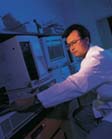 Combinatorial
Locksmith "We cancer doctors have been limited to using relatively nonspecific drugs that cause tremendous side effects, but in the last 15 years there have been many developments in the area of the molecular biology of cancer," said Lam. "We now have a much better understanding at the molecular level of how cancer becomes cancer. "With this knowledge, we can develop tens of thousands of compounds and screen for those that target the molecular defects of cancer. And we hope these target-specific drugs will be more effective and have fewer side effects." Lam's favorite metaphor for the process of combinatorial chemistry is a toy his wife, Bonnie, gave his nine-year-old daughter, Reina, four years ago. "The plastic pieces, which are all different from one another, can be mixed and matched so Reina can make whatever she wants," he said. "It's like combining pieces of molecules to make a variety of combinations whose effectiveness as a cancer drug can be tested." The trick is knowing just exactly which of these syntheti- cally created molecules will produce the desired outcome. For this next step, different metaphors are invoked. Mario Geysen of the pharma- ceutical company Glaxo Wellcome Inc., who has worked on drug development since the early 1980s, used tennis balls to describe the process to a Dallas Morning News reporter last year: "Suppose you were given a million tennis balls, and one of them had a gold nugget in it. And I told you that you could keep it if you find it in an hour. The quickest way to find it would be to divide the balls into two batches of exactly 500,000. The heavier would have the gold. By dividing the heavier sets again and again, only one tennis ball would eventually be left." Others use a safe with an unknown combination to describe the challenge of finding just the right compound. To open the safe one would have to try an unwieldy series of different combinations of numbers until ferreting out just the right one. It would take eons to develop one drug, never mind the many that cancer researchers are seeking. It is in this critical needle-in-the-haystack step of combinatorial chemistry where Lam has made a major contribution. While at the Arizona Cancer Center, Lam developed a method for creating a kind of chemical library that contains more than a million different peptides, the short stretches of protein molecules responsible for the work of a cell. Using this landmark library, chemists can run thousands of chemical reactions simultaneously. To achieve this tour de force Lam was able to fix each peptide to a different plastic bead the diameter of a human hair. He first divided the beads into 20 groups and exposed each group to a reaction solution that added one of 20 different amino acids, the subunits that make up the peptide. As a result, the amino acid was chemically bonded to each bead. He then washed the beads, divided them into 20 groups and exposed them to another 20 different amino acids, which in turn proceeded to bond to the amino acid already on the beads to form a peptide chain. After five such steps, he had - all in a matter of 48 hours - 3.2 million different new compounds, each on a separate bead, and each of which could be evaluated for biological activity simultaneously This one-bead, one-compound approach led to further developments that now allow chemists like Lam to create a circular chemical molecule with several different side-branches extending from the circle, where hundreds of different possible building blocks can be added to several different sites on a molecule. This addresses the need for effective cancer drugs to unlock a particular protein - one of potentially several - in the cancer cell. "With this method," said Lam, "we can potentially identify compounds that bind to a variety of cancer targets at different parts of the cancer cell: the envelope or surface coating of the cell, the interior of the cell or those in the nucleus. Some of these compounds may eventually develop into effective anti-cancer drugs." This process is further facilitated with advances in computational chemistry, which employs highly sophisticated computers to make models of the molecular structure of the target protein and the potential drug, and robotics, which greatly speeds the process by performing such mechanical tasks as routine biological or biochemical assays. Armed with new, faster ways to find anti-cancer compounds, Lam describes himself as cautiously optimistic about the potential for finding a cure for cancer. "The clinical trials process is still the bottleneck," he said. "We have the technology now to develop lots of compounds quickly and efficiently, but they still need to be tested for their effectiveness, toxicity and dosage levels, initially in animals and later in humans. That's a tremendously costly and time-consuming process." Physician-scientists, he said, continue to need time, space and money to do their research, none of which is in ample supply in this day of managed health care, where seeing more patients often trumps a physician's research. "But we are beginning to have a critical mass here at the medical center in Sacramento," said Lam. "We need to continue to expand the research program in cancer and to take full advantage of the researchers on the Davis campus who have lots of expertise in vari- ous related areas. We also need the university and the health system to support this work so the program can reach its full potential."
Home |
Table of Contents |
To our Readers |
Building on Basics UC Davis Health System | © 2000, 2001, 2002 UC Regents. All rights reserved. |
A machine gently shakes stock solution used in combinatorial chemistry.
Gang Liu watches sample analysis on a high-performance liquid chromatography (HPLC) machine. |


